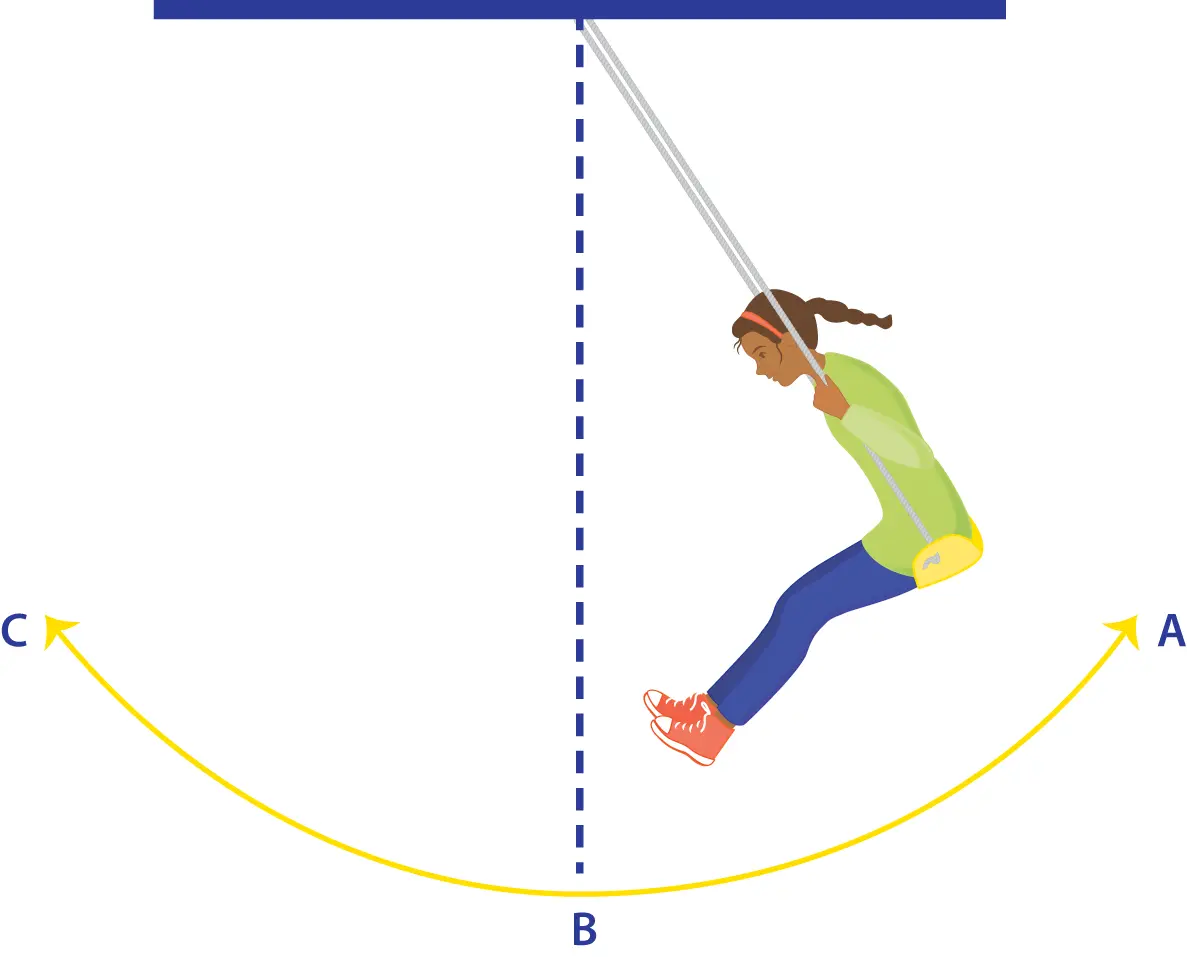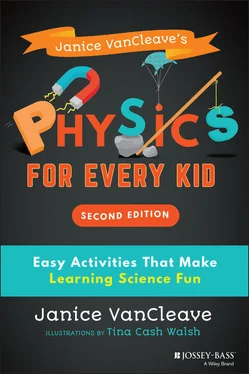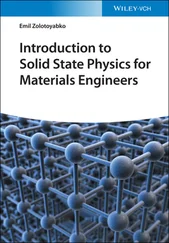Janice VanCleave - Janice VanCleave's Physics for Every Kid
Здесь есть возможность читать онлайн «Janice VanCleave - Janice VanCleave's Physics for Every Kid» — ознакомительный отрывок электронной книги совершенно бесплатно, а после прочтения отрывка купить полную версию. В некоторых случаях можно слушать аудио, скачать через торрент в формате fb2 и присутствует краткое содержание. Жанр: unrecognised, на английском языке. Описание произведения, (предисловие) а так же отзывы посетителей доступны на портале библиотеки ЛибКат.
- Название:Janice VanCleave's Physics for Every Kid
- Автор:
- Жанр:
- Год:неизвестен
- ISBN:нет данных
- Рейтинг книги:5 / 5. Голосов: 1
-
Избранное:Добавить в избранное
- Отзывы:
-
Ваша оценка:
- 100
- 1
- 2
- 3
- 4
- 5
Janice VanCleave's Physics for Every Kid: краткое содержание, описание и аннотация
Предлагаем к чтению аннотацию, описание, краткое содержание или предисловие (зависит от того, что написал сам автор книги «Janice VanCleave's Physics for Every Kid»). Если вы не нашли необходимую информацию о книге — напишите в комментариях, мы постараемся отыскать её.
Janice VanCleave's Physics for Every Kid: Easy Activities That Make Learning Science Fun, 2nd Edition
Physics for Every Kid
Physics for Every Kid
Janice VanCleave's Physics for Every Kid — читать онлайн ознакомительный отрывок
Ниже представлен текст книги, разбитый по страницам. Система сохранения места последней прочитанной страницы, позволяет с удобством читать онлайн бесплатно книгу «Janice VanCleave's Physics for Every Kid», без необходимости каждый раз заново искать на чём Вы остановились. Поставьте закладку, и сможете в любой момент перейти на страницу, на которой закончили чтение.
Интервал:
Закладка:
Gravitational potential energy is the stored energy an object has because of its position above a specific ground zero. This type of potential energy is due to the force of gravity acting on the object. To obtain this energy, work had to be done on an object to raise it to a higher level above ground zero, such as placing a book on a top shelf with the floor below being ground zero. Gravitational potential energy is directly related to the mass of the object as well as its height above ground zero. When the book is dropped from a specific height, its gravitational potential energy is converted to kinetic energy as the book falls.
Elastic potential energy is the energy stored in an object that can be stretched or compressed. A force is needed to compress or stretch an elastic object. Consider a trampoline, which has the greatest elastic potential energy when it is stretched the most, as does a rubber band. A coiled spring stores elastic potential energy when a force compresses it as well as when a force stretches it. In both cases, when the spring is released, the spring's elastic potential energy results in the wound coils moving back to their normal position. Thus, the elastic potential energy is converted to kinetic energy.
Kinetic energy( KE) is the energy of objects that are moving. Remember, kinetic energy does not cause an object to move, instead objects have kinetic energy because they are moving. A ball at the top of a ramp has gravitational potential energy. As the ball rolls down the ramp, its gravitational potential energy is converted to kinetic energy. There are three types of kinetic energy: vibrational, rotational, and translational. Vibrational KEis the energy caused by a back and forth movement; rotational KEis the result of turning about an axis, and translational KEis the result of linear movement from one place to another.
Mechanical energyis the sum of an object's potential energy and kinetic energy. Objects have mechanical energy if they are moving or have positional potential energy. Remember that an object doesn't have to be a machine to have mechanical energy. For example, both rivers and wind have mechanical energy.
In addition to mechanical energy activities, other types of energy will be investigated: sound energy, electrical energy, and light energy.
Soundis the sensation perceived by an organism's sense of hearing produced by the stimulation of hearing organs by sound waves. Sound energyis a type of energy produced by vibrating objects, such as when a guitar string is plucked. The movement of the string moves the air around it, producing a pattern of disturbances in the air called sound waves. Sound energy is transferred through mediums, such as solids, liquids, and gases. This type of energy can be heard by humans and other animals.
Electricityis a type of energy that we often take for granted until it is not available. All electric appliances, including computers and TVs do not work if the electric power line bringing electrical energy to your home is broken during a storm. You will discover more about current electricityas well as how to perform magic tricks using static electricityin the activities included in this book. You will also learn how the chemical energy stored in batteries produces the current electricity necessary for cell phones and tablets. Other electrical terms such as free electrons, conductors, insulators, polarization, and closedand open circuitswill be investigated in the activities related to electrical energy.
Light energyis radiation. Radiationis a type of wave energy that does not need a medium to move through, such as radiation from the Sun that moves through space to Earth. The term radiation can sound dangerous and frightening, but did you know that common visible light and heat waves, called infrared light, are all forms of radiation? We can't imagine homes without our useful microwave oven. There are seven types of radiation: gamma rays, X-rays, ultraviolet light, visible light, infrared light, microwaves, and radiowaves.
1 Energy Conservation
The Law of Conservation of Energystates that energy is neither created nor destroyed. Instead, energy can be converted, or changed, into another form of energy. In this activity, the mechanical energy of a pendulum will be investigated. Mechanical energyis the summation of an object's potential energy(stored energy) and kinetic energy(energy of moving objects). A pendulumis a weight, called a bob, hung from a fixed point so that it can freely move backward and forward. Each swing of the bob, from one side to the other forms an arc, as shown in Figure 1. Work is done on the pendulum when it is raised to position A. This means that energy is being transferred to the pendulum. When raised, the pendulum gains gravitational potential energy, which is stored energy due to an object's height. When released, gravity pulls the pendulum down and its gravitational potential energy is converted into kinetic energy.
Gravityis the force of attraction between any two objects with mass in the Universe. The greater the mass, the greater is an object's gravitational force. Earth is very massive; thus, it attracts objects near or on its surface in a direction toward its center. At position A, the pendulum has maximum gravitational potential energy, which is changed to kinetic energy as the pendulum swings down to position B. From position B to C, the pendulum is moving against the downward force of gravity; thus, it slows. During this upward part of the swing, the pendulum's kinetic energy changes into gravitational potential energy again.

FIG 1
The mechanical energy of a pendulum involves the transfer of kinetic energy into potential energy and back to kinetic energy, and so on. It is important to note that the amount of potential energy at position C is less than it was when the pendulum was first lifted to position A ( Figure 1). This means the pendulum loses mechanical energy with each swing and each swing is lower and lower until it finally stops. This lost energy was changed into another form of energy, such as heat or sound (air vibration).
See for Yourself
Materials
string, 8 inch (20 cm)
tape
washer with a hole or any comparable weight
What to Do
1 Tie one end of the string to the washer.
2 Tape the free end of the string to the edge of a table ( Figure 2). FIG 2
3 Pull the pendulum to the side a short distance and release. It should swing back and forth. Observe the movement of the pendulum. Make note of the pendulum's height during each swing.
What Happened?
In Figure 1the pendulum is first held stationary at position A, which is higher than position C. This means work has been done on the pendulum by lifting it, giving the pendulum gravitational potential energy. When the pendulum is released, the force of gravity acts on the pendulum pulling it downward. When moving, the pendulum has kinetic energy. Halfway between A and B, half of the mechanical energy is divided between potential energy and kinetic energy. At position B, the potential energy of the pendulum is zero and the kinetic energy is at its maximum. This kinetic energy decreases as the pendulum moves toward position C. Halfway between B and C, mechanical energy is again divided between potential energy and kinetic energy. Finally, the pendulum rises slightly below position C. In this position, its potential energy is less than at the start of the swing. This reduction of mechanical energy decreases incrementally until the pendulum stops moving and hangs vertically at a standstill at position B.
Читать дальшеИнтервал:
Закладка:
Похожие книги на «Janice VanCleave's Physics for Every Kid»
Представляем Вашему вниманию похожие книги на «Janice VanCleave's Physics for Every Kid» списком для выбора. Мы отобрали схожую по названию и смыслу литературу в надежде предоставить читателям больше вариантов отыскать новые, интересные, ещё непрочитанные произведения.
Обсуждение, отзывы о книге «Janice VanCleave's Physics for Every Kid» и просто собственные мнения читателей. Оставьте ваши комментарии, напишите, что Вы думаете о произведении, его смысле или главных героях. Укажите что конкретно понравилось, а что нет, и почему Вы так считаете.












